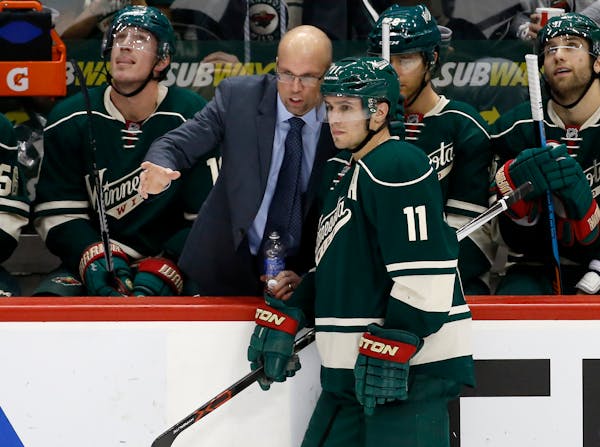At the end of November, the Wild looked like a team in trouble. Head coach Mike Yeo held a practice in which he sent a message to players about consistency and hard work. There appeared to be public tension between Yeo and his two best players, Zach Parise and Ryan Suter.
The Wild had a record of 11-7-4 at that point — not bad by any means, but there were cracks and questions nonetheless for a team with aspirations beyond just making it to the playoffs again.
The tension dissipated, as it often does, with a string of immediately improved play. The Wild started playing the way Yeo had preached — tough on the puck, tough to score on, winning some games ugly if it had to. Minnesota rattled off a 6-0-2 streak right after the conflict, allowing just seven regulation goals in those eight games. All was right with the world …
Until now, when we find ourselves right back into the territory of a season, at least, with question marks. Yeo and Parise spent much of Thursday's practice talking things over, dialogue needed after some recent ugly home losses.
As it stands, there is some interesting symmetry in the Wild's two chunks of this season — and some numbers that allow us to ask an important question: When the Wild is at its best, what style is it playing?
If we can think of roughly the first quarter of the season (22 games) being the 11-7-4 span before the first round of team-in-turmoil stories, then the next quarter has been the nearly identical record-wise 11-6-4 span (21 games) starting right after that stretch. What we've seen in those spans are two very different versions of the Wild.
*In the first 22 games, Minnesota scored 62 regulation goals (2.82 per game) and allowed 57 (2.59 per game). The Wild had 74 power play chances and converted 15 of them into goals. In short, the Wild was generating a lot more offense. But Minnesota's game was also a little "loose," as they say, and it was perhaps leading to chances the other way (though there were other factors at play, as we'll see in a minute).
*In the next 21 games, Minnesota scored 50 regulation goals (2.38 per game) and allowed 37 (1.76 per game). The Wild had 49 power play chances and converted seven of them into goals. Minnesota's game, in essence, tightened up. But the end result was a record almost identical to the one produced playing the other way.
*Puck possession and other metrics were pretty much the same during both stretches, so for some more analysis let's head inside the crease. Obviously the Wild was allowing a ton more goals in the first quarter of the season that the second (nearly a full goal per game). Was that a function of the style of play or the quality of goaltending the Wild was receiving?
Here's where it gets interesting because I tend to believe based on some critical stats that it wasn't the fault of the style.
War On Ice, a great site, breaks down the goals allowed by netminders into three categories: low-danger, medium-danger and high-danger. It's an imperfect designation, but in general you can surmise that a low-danger goal allowed is a soft goal, a medium-danger goal is one you'd like to see stopped but could go either way and a high-danger goal is one in which the shooter was in a prime scoring position and a very good save would have been required to stop it.
In the first 22 games of the season, here is the breakdown of the types of goals allowed by Devan Dubnyk and Darcy Kuemper: 27 high-danger, 17 medium-danger, 12 low-danger.
In the next 21 games of the season, here's the breakdown of the types of goals allowed: 26 high-danger, 6 medium-danger, 4 low-danger.
So Dubnyk and Kuemper are still giving up about the same number of quality goals. But whereas they gave up 29 combined soft or questionable goals in the first 22 games, they've given up just 10 since then. That leads me to believe the Wild's stinginess in allowing goals recently isn't primarily a function of a "tighter" game but that of simply better goaltending and more routine shots being stopped.
That knowledge helps answer the ultimate question: what style is the Wild best off playing? One that is more up-and-down in which it scores more often, as it was playing earlier, or one that is tighter and leads to fewer goals scored but also has coincided with fewer goals allowed?
The answer is a bit of a copout, since a team must be able to win both ways in the NHL. But if I had to pick, I'd say I prefer the Wild of the first 22 games over the Wild of the last 21. Assuming my assessment of the goaltending is correct, there's no reason this team can't score more AND be stingy in allowing goals.
Maybe that's what Parise and Yeo were talking about Thursday?
Regardless, it will be interesting to see what the next quarter of this season and beyond brings for the Wild, beginning tonight against Winnipeg.
In heated western Minn. GOP congressional primary, outsiders challenging incumbent

Minnesota Sports Hall of Fame: A class-by-class list of all members

This retired journalist changed professional wrestling from Mankato

